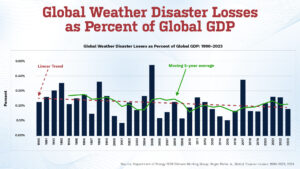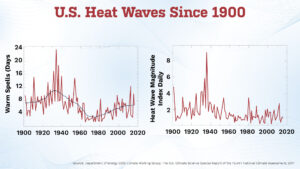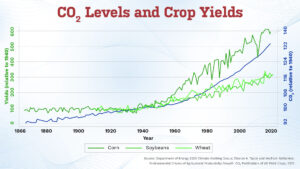
Let’s Have a Real Climate Discussion
August 25, 2025
A real climate debate and discussion.
At TEA, we believe in science. But, any real scientist will tell you that their work is rarely a clear-cut, black-and-white affair. It’s a craft that is always changing and always seeking new information. Unfortunately, far too often nowadays, when we’re discussing climate, the word “science” is only thrown around to shame and shutdown real discussion and discourse.
Energy Secretary Chris Wright is looking for something different, as he puts it “a real debate and discussion about climate change, and get away from the cancel culture.” That’s why the Department of Energy (DOE) recently released a report called “A Critical Review of Impacts of Greenhouse Gas Emissions on the U.S. Climate.” The purpose of the report is to evaluate “peer-reviewed literature and government data on climate impacts of Greenhouse Gas (GHG) Emissions and providing a critical assessment of the conventional narrative on climate change.”
Here’s some of the most interesting findings in the report.
Economic losses from climate change don’t add up.
Just a few months ago, the New York Times published a headline, “Climate Change Could Become a Global Economic Disaster.” Their article was based on information from “financial firms and insurers.” Because, you know, financial firms and insurers don’t have any interest in scaring people into buying more flood insurance on their house or investing in underperforming “green” mutual funds.

According to the DOE report (see p. 118 for all the scholarly sources the report cites): “While extreme weather events are costly, in all modern economies they are becoming steadily less and less important. Since 1990 weather-related disaster losses have declined as a proportion of global GDP as have mortality risks. While economic weather-related insurance payouts are rising, this is fully explained by the growth in the size of the economy and the value of the insured asset stock. Past increases in episodes extreme weather have not had a significant effect (positive or negative) on the market value of insurance firms. Nor have past extreme weather events had a significant effect on U.S. banks’ performance; warming has even been shown to be beneficial for the finance and insurance sector. … For these reasons, economists have long been reluctant to endorse attempts to ‘stop’ climate change or even aggressively reduce GHG emissions because the costs would not be worth it.”
So, according to actual scientists, not insurance companies, the claims of global economic losses don’t add up.
Just in time for hurricane season.
We’ve all been watching the waves from Hurricane Erin on the weather. Of course, those weather reports will be paired up with the usual climate doomsday rhetoric we hear each hurricane season—like this Washington Post headline, “Erin joined a long list of recent Category 5s. Are they happening more often?”

According to the DOE report (p. 48-50 for sources), The graph above “shows the frequency of Atlantic hurricanes and major hurricanes (Category 3 and higher) back to 1920. Data prior to 1965 (the onset of satellite observations in the Atlantic, shaded in blue) shows some undercounting, with data prior to 1920 showing substantial undercounting.” Even with apparent increases in recent decades, there are clear periods of exceptionally low activity, and there have been periods of high activity all the way back to the 1930s.
The graph shows the effects of something called the Atlantic Multidecadal Oscillation (AMO). The AMO “is manifest in basin-wide sea surface temperature and sea level pressure fluctuations connected to large scale ocean circulation patterns. The AMO was in its warm phase during 1926-1970 and 1995-present, but in its cool phase during 1971-1994. It has its greatest impact on the number of major hurricanes (Category 3+).”
So, there’s an easy answer to that question, Washington Post: Nope.
It never used to be this hot…right?
We’ve all seen these statistics, like this one from the Sacramento Bee, “Seven of the city’s 10 hottest summers on record occurred during the last 10 years, according to the federal data, which stretches back to 1948.”
Now that seems like a dire number. But, what if we stretched back a bit further? Well, heat wave magnitude reached a maximum in the 1930s. See, the science and the data tell a whole different story…if you don’t cherry pick numbers just to reinforce a false narrative.

The DOE report provides information from “The U.S. Climate Science Special Report of the Fourth National Climate Assessment”: “Changes in warm extremes are more nuanced than changes in cold extremes. For instance, the warmest daily temperature of the year increased in some parts of the West over the past century, but there were decreases in almost all locations east of the Rocky Mountains. In fact, all eastern regions experienced a net decrease, most notably the Midwest (about 2.2°F [1.2°C]) and the Southeast (roughly 1.5°F [0.8°C]). … Since the mid-1960s, there has been only a very slight increase in the warmest daily temperature of the year (amidst large interannual variability).”
But, it never used to be this hot…right? Well, “heat waves (6-day periods with a maximum temperature above the 90th percentile for 1961–1990) increased in frequency until the mid-1930s, became considerably less common through the mid-1960s, and increased in frequency again thereafter. As with warm daily temperatures, heat wave magnitude reached a maximum in the 1930s.” So, actually, it did.
Crops love CO2
We’ll go ahead and say the taboo thing out loud: More carbon dioxide (CO2) might even be a good thing. For example, when it comes to farming, an increase in CO2 leads to bigger crop yields for corn, wheat and soybeans.

According to the DOE report (p. 106 for sources), “A 2021 report from the U.S. National Bureau of Economic Research used satellite-measured observations of outdoor CO2 levels across the United States, matched to county-level agricultural output data and other economic variables. After controlling for the effects of weather, pollution and technology the authors concluded that CO2 emissions had boosted U.S. crop production since 1940 by 50 to 80 percent … They found that every ppm of increase in CO2 concentration boosts corn yields by 0.5 percent, soybeans by 0.6 percent, and wheat by 0.8 percent.”
Honest discourse leads to solutions.
We like solutions. That’s why TEA has pushed ARC ES legislation to provide affordable, reliable and clean energy security for all Americans. And, that’s why we’ve got a Common Sense Energy Agenda to work us toward that goal.
Now, we’re finally seeing the thoughtful consideration of ALL data and an honest discussion around climate science that we’ve been waiting for. The reason this debate has dragged on for decades with little progress to show is due to this lack of fair debate. How can we find real solutions when we can’t even talk about what the real problems are?